You may have seen reviews that offer a Beefer vs Otto Wilde grill review, or Beefer vs Northfire Inferno grill review, or maybe even Inferno vs Otto Wilde grill review. Today, we’re going head-to-head-to-head with a deep dive into all three.
If you’ve been lucky enough to peek into the kitchen at a fancy steakhouse, you’ve gotten a glimpse of modern mortals who have mastered the grill and are cooking up sometimes 500 or more steaks in a single evening.
Every restaurant and steakhouse that serves a succulent sirloin or a mouthwatering ribeye has their own standards for the quality of the meat they are cooking and the way it’s prepared. Trade secrets about how long meat is aged, or what seasonings go into a rub, are not often shared with more than a few folks. But one thing remains constant at all notable steakhouses:
Cooking a steakhouse quality steak requires a significant amount of heat.
So much heat, in fact, that most (not all) average backyard gas grills or barbecues can’t get half as hot as the cookers you’d see in the back of a restaurant.
Until now.
One of the secrets steakhouses use to achieve ridiculously hot temperatures is to cook with what restaurant cooks call a Salamander. A Salamander is an over-fire broiler where the food is cooked from the top down, the opposite of how your backyard grill cooks. Salamanders are capable of reaching very high temperatures. In addition to cooking steaks, they are great for browning, broiling, melting cheese, toasting, and warming plates.
Commercial Salamander cookers however, are expensive, large, and—due to the high temperatures—just impractical for the average Joe to have in the kitchen.
Manufacturers have recognized that consumers have more room for additional appliances on the patio than they do in the kitchen and have recently introduced infrared over-fire broiler grills to the home cook.
We tested three of the most established Salamander-style infrared grill brands to learn about the differences between each of them and help you decide which is best for your needs.
Basic Operation of Infrared Grills
The infrared grills we tested all operate similarly and claim to reach temperatures around 1500°F. Fire up the grill and allow it to preheat for about 10 minutes. Start with the grill’s grates removed. Cold meat goes on to the grate just prior to cooking and is slid into the grill.
Infrared Grill Heat Is Controlled Two Ways
Like any other gas grill, these grills have a temperature control knob that regulate the amount of gas sent to the burner. The knobs can be adjusted from high to low. Although we can think of a variety of benefits for adjusting temperatures, for this testing, the grills were all cooking at full blast.
The second way to control the temperature is by adjusting the food’s proximity to the heat source.
The Original Beefer Grill and Inferno Grill have different levels of notches the grill’s grates sit on at set distances from the heat source. The Otto Grill and Beefer XL both have a handle that can raise and lower the grill grate to your desired proximity to the heat.
During testing we had issue with both designs. The notches are just plain cumbersome and not user friendly; giving the feeling that they’re an accident waiting to happen. This design also causes a sizable mess on the deck, or patio from the drippings coming off the food on the grate as it’s removed from the cooker and placed on a different level.
The handle designs are much better, but still felt clunky and less than smooth. The design is sound, but the execution on both units just felt like it wasn’t as smooth as we would have liked, with the Otto Wilde being noticeably smoother than the Beefer XL, but still not great.
Grills Reviews:
Single Burner Grills
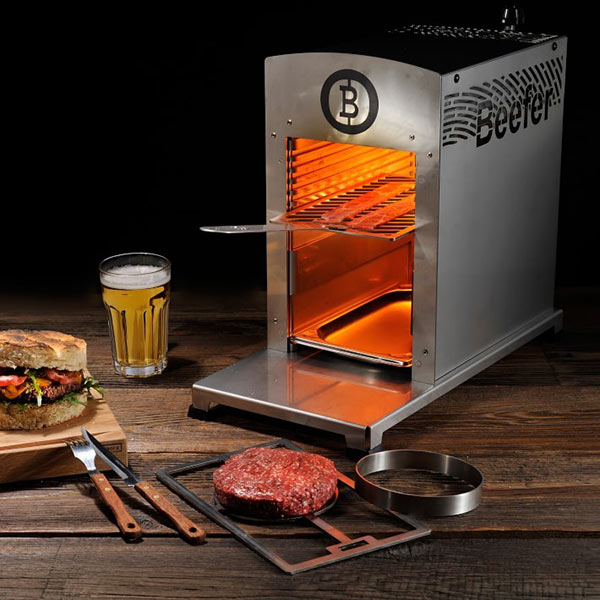
Beefer Grill—$699
Included in delivery:
- Beefer
- 2 x Gastronorm drip trays
- 1 x grill glove
- 2 x grill grates
- 1 x handle
- gas hose (1.0 m in length)
Specifications:
- Burner temperature > 1,500°F
- Tested according to Gas Appliance Directive 2009/142/EC
- Category: I3P (30) propane
- Nominal heat capacity: 3.5 KW
- LPG-powered grill appliances for outdoor use
- Size W: 9.1” | H: 15.7” | D: 18.6”
- Weight: 35 lbs.
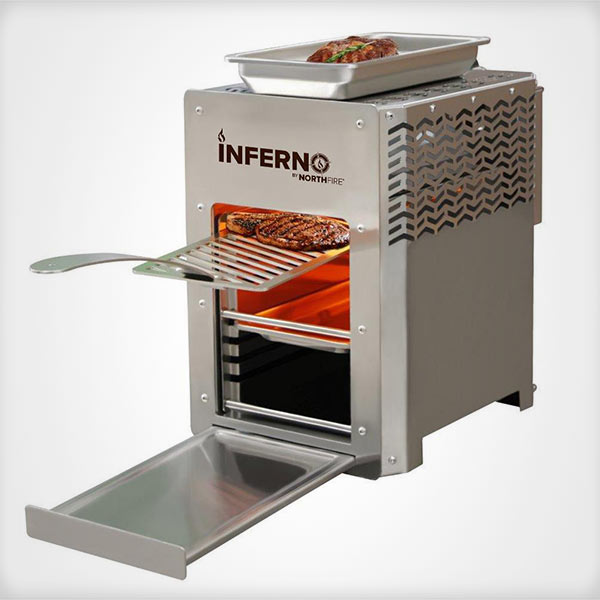
Northfire Inferno Grill—$499
Specifications:
- Size W: 10” | H: 17” | D: 14”
- Grill Plate: 6” x 11”
- Drip Tray: 1/2” deep
- Food Tray: 7/8” deep
- Propane Hose Length 39.5”
Both of the smaller grills we tested were well-packaged and arrived ready-to-use almost immediately after unboxing.
The Beefer Grill has six positions for its grill grate—from directly under the infrared burner to about four inches below the burner. Along with the grill grate, Beefer comes with two Gastronorm drip trays that can be used to collect juices. If you’re feeling fancy, put foods like asparagus, potatoes, or other veggies in the drip tray and get some extra flavor to your meal. All grates, trays, and shelving can be quickly removed for easy cleanup and are dishwasher safe.
The Northfire Inferno Single burner propane infrared grill is strikingly similar in design and operation to the Beefer Grill. The seven notches in the grill rack determine the grates proximity to the infrared heat source. The first four notches or levels are clearly for a hard sear, char, or quick melt. The lower three notches will roast or grill meat but not as intensely as when the grates are in a raised position.
Changing positions of the grill grate on both units resulted in drips of rendered fats landing on the deck surface. There was also some difficulty lining the grate up perfectly into the grooves, making it an awkward transition.
Double Burner Grills
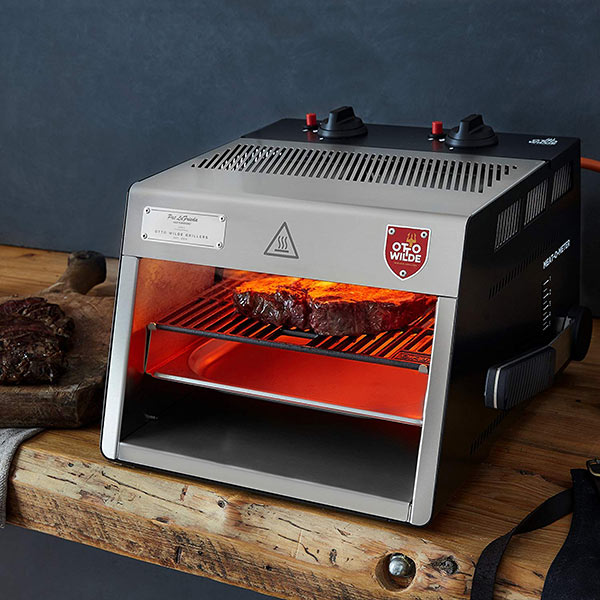
Otto Wilde Grill—$1195
Specifications:
- Size W: 16.7″ | D: 17.3″ | H: 11.6″
- Corpus material: stainless steel
- Weight: 39.7 lbs.
- Burner: 2 separately adjustable infrared gas units
- Gas type: Propane
- Ignition2 piezo ignitors
- Temperature range: Up to 1500°F
- Grid size: 12.8 x 10.4 in.
- Material grid: Cast iron
Package Includes:
- Constructed of premium 304 stainless steel.
- A gas hose (3 ft.) with regulator
- Stainless steel drip tray
- Stainless steel, rubber coated drip tray tongs for ideal grip of the drip tray
- Clever Lever, height adjustment, grid allocation and bottle opener—all in one.
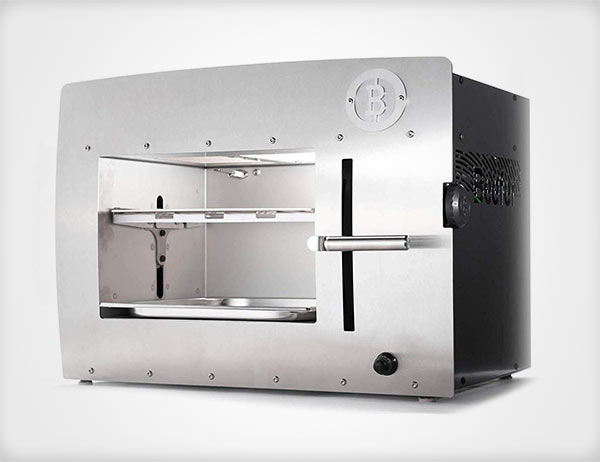
Beefer XL Grill—$1599
Dimensions:
- SIZE W 25.6” | H 18.5” | D 19”
- Weight 74.95 lbs.
- Temperature burner >1,500°F
Package includes:
- Beefer XL with gas hose (1 m)
- Pressure regulator
- Grand grill grate
- Grill glove
- Two grill grate handles
- GN tray for fat and juice
- Igniter batteries
The size of these two grills are significantly larger than the Beefer and Inferno units. With two burners there is more space available for cooking, which could be a real benefit when you are cooking for more than a guest or two.
Both of these grills have a handle that slides up and down controlling how close you can get food to the burner. The handle adjustment is was smooth and comfortable on the new units. However, after extended use both handles (especially the Beefer XL) felt like they were binding throughout the cycle of the lever.
Testing:
Each of the manufacturers provided grills for testing and openly communicated with us regarding the benefits of their products.
The max temperature of 1500°F is an extremely hot temperature and we wondered if the grills could achieve these temperatures as advertised.
With these grills having the ability to reach such high temperatures, figuring out how to accurately measure the devices became a challenge. Most quality digital probe thermometers max out at about 600°F with probes failing soon thereafter.
Having burned through a few probes in our time, we reached out to ThermoWorks, the makers of high-quality precision temperature measuring and monitoring devices. We’ve used ThermoWorks products for years and have found their products consistently reliable and accurate, making them an indispensable part of my cooking process.
ThermoWorks sells a product called ThermaData® 2-Ch. Type K Thermocouple Data Logger they thought would complement our testing. The ThermaData device logs data and allows us to test the infrared grills over a period of time and then analyze the data when things cool down. ThermaData’s range from -148 to 2501°F (-100 to 1372°C) gives us plenty of room to collect data.
With two channels or the ability to collect temperature data with two different probes at the same time, the ThermaData was perfect for testing the grills’ grate temperatures.
Having seen infrared cameras that monitor temperatures for industrial applications, like measuring how hot a power grid’s transformer can get or finding a failing compressor in a large freezer, we decided to see if these cameras would work in our testing. We also wanted to measure the thermal output of the grills and get a true sense of how much heat was being sent from the burner to the food.
Although ThermoWorks doesn’t currently manufacture an infrared camera-measuring device, they advised us that FLIR cameras should work well for this project.
For this portion of the testing we used the FLIR T1020sc series camera, capable of monitoring and recording temperatures between -40°C to 2000°C (-40°F to 3632°F) and documented the findings with digital images.
Between the ThermoWorks ThermaData® and the FLIR T1020sc, we were able to get a more accurate understanding of how these grills perform than taking the manufacturers’ word at face value.
Testing happened over a series of sessions when the air temperature was around 75°F with low humidity. Wind conditions during testing were either calm or very light at about 3 MPH. Although we never experienced any performance issues due to wind, some backyard cooks who own these grills have reported that on windy days they have seen their units blowing out on occasion.
Interestingly, the makers of the Inferno grill reached out to us before testing to suggest that if wind was present during testing (or cooking), we should consider positioning the grill so it’s less susceptible to being blown out. Although this should be common sense, we appreciated the heads-up.
The temperature recording devices used here are products typically installed and used by professionals. Although we try to keep the testing as consistent as possible from grill to grill, there are variables that could change the outcome of the results. To keep the testing as consistent as possible we adhered to the following rules:
- Grills were tested on the highest setting with the valves the most wide open for maximum temperature
- Grills were pre-heated for 20 minutes prior to testing
- The main temperature probe was placed as close to flush on the grill’s grates as possible and in the setting closest to the heat source in an effort to mimic food on the grill’s grates
- Temperatures were sampled at consistent intervals over a course of 20 minutes after pre-heating
- A bread test was conducted on all devices to illustrate the heating and cooking pattern of the infrared burners
Beefer Grill
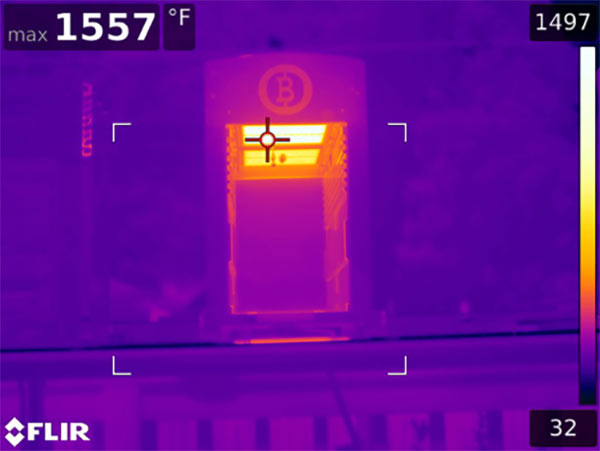
The Beefer Grill max temperature hit 1557°F measured with the infrared FLIR camera and 931°F with the ThermoWorks device.
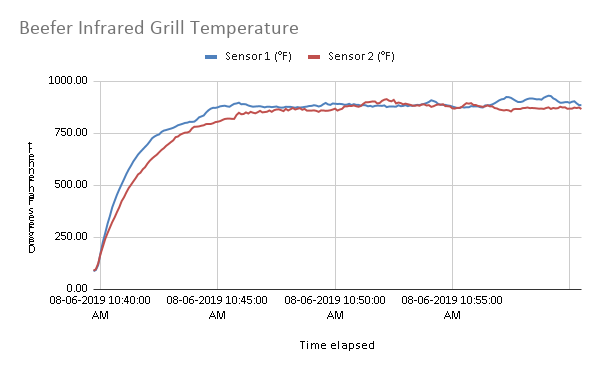
The bread test indicated that the majority of the heat’s concentration came from the back rear left corner of the grill and became less intense toward the front of the grill.
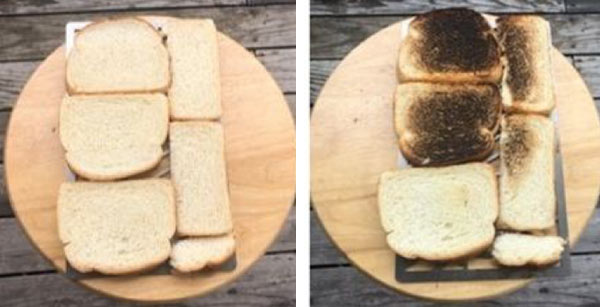
The Beefer Grill came with a variety of accessories like a pizza stone and peel and some long, narrow tongs we found fun to use and experiment with. It’s sturdy, consistent and gets the job done.
The ignition system on the Beefer is a bit awkward compared to the other grills, as it’s hard to light the unit from the rear and be able to see inside the grill at the same time. This is more of an inconvenience and does not affect the cooking, but worth mentioning.
Inferno Grill
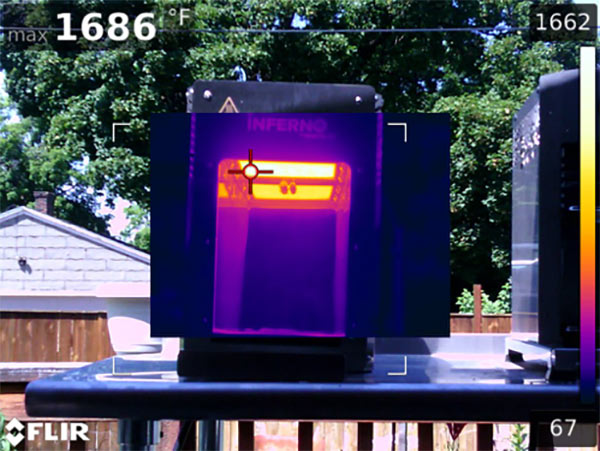
The Inferno Grill max temperature hit 1686°F measured with the FLIR and 1153°F with the ThermoWorks device.
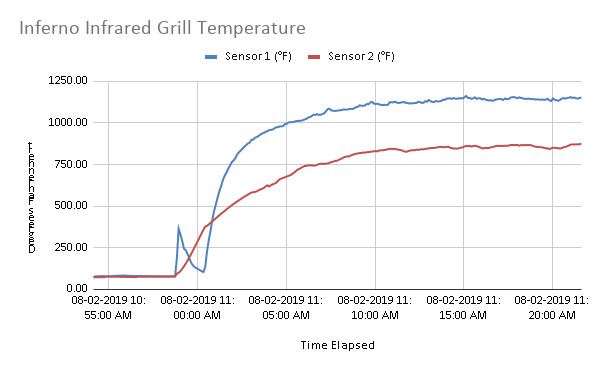
The Inferno Grill looks and operates very similarly to the Beefer but there are some subtle differences between the two. The Inferno has an internal scaffolding that the grill’s grates sit on that slides in and out of the grill.
Although we couldn’t determine what exactly the benefit is of this grate setup, we also couldn’t find anything wrong with it other than the aforementioned awkwardness and mess.
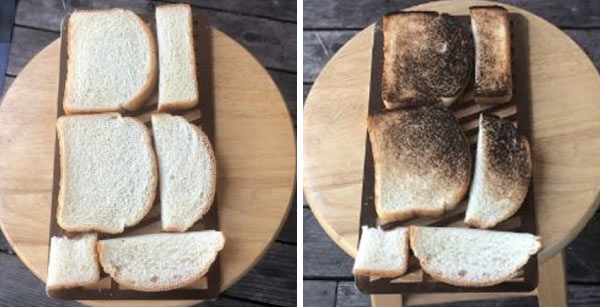
Bread testing showed a consistent amount of heat transferred to the food, strongest at the rear of the grill and much less intense toward the front third of the cooker.
Otto Grill
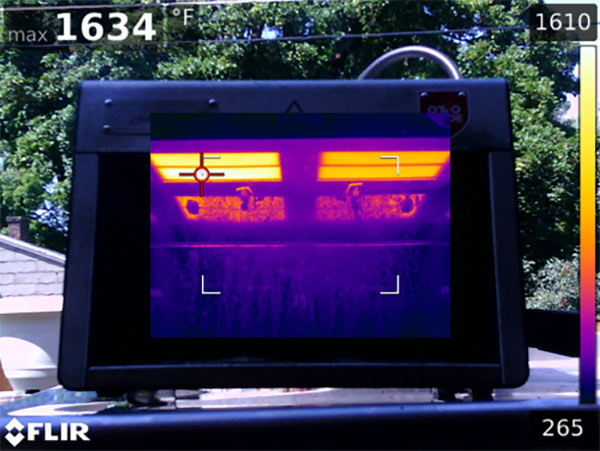
The Otto Grill max temperature hit 1634°F measured with the FLIR and 1342°F with the ThermoWorks device.
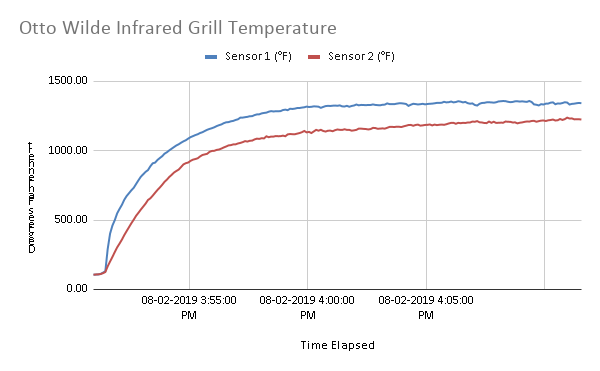
With two independent burners, Otto Grill is the only one to use a Piezo sparking igniter that requires no batteries.
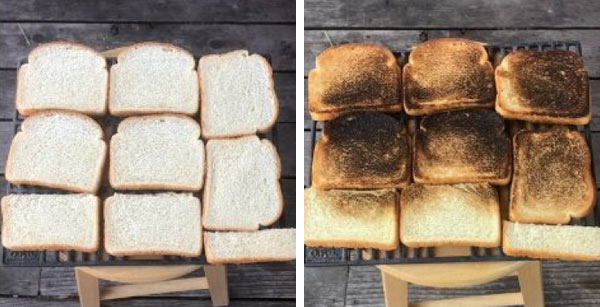
Of the four grills tested the Otto provided the most smooth and consistent heat across the cooking surface evident from the bread test.
The grilling surface smoothly transitions to and from the heat source. The handle that raises and lowers the grill’s grate can also be used to assist with sliding the grate in and out.
Otto is possibly one of the most primally satisfying over-fire broilers to use but there are some details we didn’t love.
The propane hose that came with our grill is too short and when the unit sits at countertop height, a 20 lb. propane cylinder needs to rest on something between it and the ground. Disappointing to say the least.
The unit is extremely challenging to take apart to clean. We asked a manufacturer’s representative to demonstrate the process at a trade show and it took a lot of elbow grease and open hand whacking for the grill to come apart.
Otto would also benefit from a catch or a way to allow the user to pull out the grill’s grate to peek at the food without the grate falling completely forward. None of the inconveniences really affect how the device cooks or if it makes your steak taste better but for an award winning design we’d hope they look more creatively into future offerings.
Beefer XL Grill
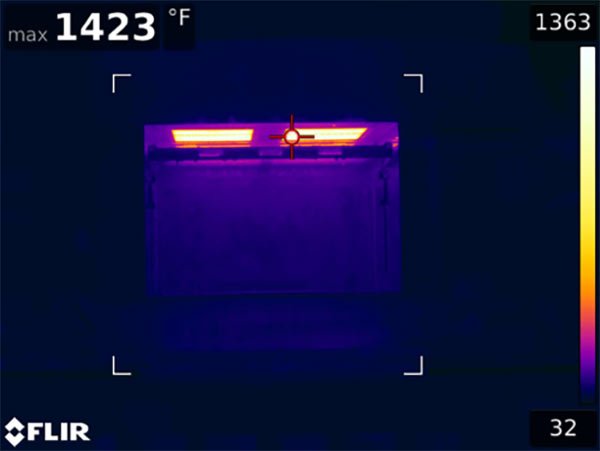
The Beefer XL max temperature hit 1423°F measured with the FLIR and 1148°F with the ThermoWorks device.
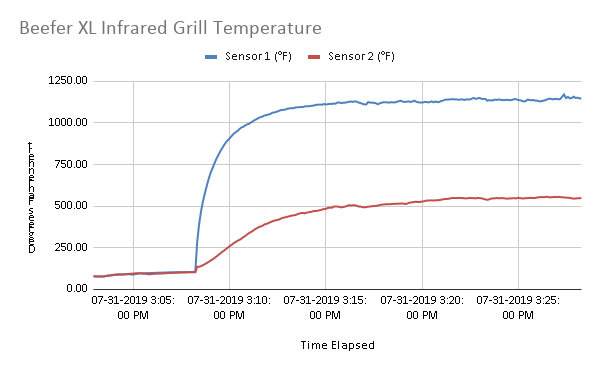
The bread test revealed a slightly inconsistent pattern of browning resembling the burners’ placement inside the grill.
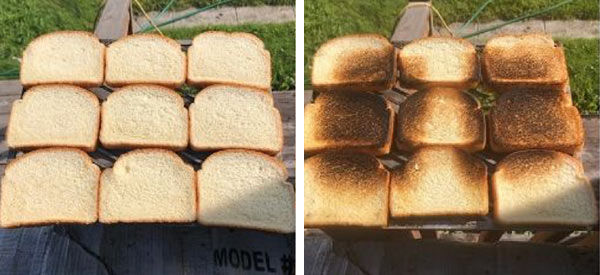
You don’t have to be an award winning chef or grill master to feel like one using the Beefer XL. This thing is burly. Weighing in at close to 75 pounds, it’s a little bit heavy to pack along for long walks on the beach but it more than makes up for it in other ways.
The Beefer XL has our favorite ignition system. With the igniter on the front of the unit you can clearly watch the unit ignite as your mind wanders toward a delicious steak.
The handle, which raises and lowers the grill’s grate toward the burner, feels like something out of a fighter jet. Flat and sturdy, we love the way this handle feels in your hand and the sense of power you get when you raise food toward the flame. That said, the actual lineal motion of the Beefer XL grate became very rough after extended use of the unit.
The Beefer XL lights fast, heats quickly and has plenty of room for a complete dinner.
Conclusion:
UPDATE: A newcomer to the space has taken the crown in the field of personal salamander style broilers. The Schwank Grills unit has edged out the Otto Wilde as the clear cut winner. See the Schwank Grills review here.
Naysayers may argue that over-fire broilers like the ones tested here are unnecessary, one trick ponies, but we disagree.
As previously unheard of cooking methods like pellet smoking, pressure cooking and sous vide cooking become more popular, they are deficient in that they don’t char meat. Over-fire broilers actually solve that problem. As we know, the char is where the flavor comes from via the Maillard reaction. These salamander style grills make the perfect complement to those methods of cooking.
These grills excel at cooking steaks up to about an inch thick, and for most people a steak is what comes to mind when you think of this style of cooking. But as more of these grills make their way onto patios, the more we will see people branching out and cooking things like seared ahi, charred carrots, oysters Rockefeller, and even raclette over steamed (or grilled) veggies.
Of the grills tested, we found the Otto Wilde to be the winner of the “showdown.” It doesn’t come without some minor previously addressed issues.
Despite those issues, we’d recommend the Otto Wilde to anyone looking for this style of cooker as it’s performance and overall cooking ability was markedly better than competitors.
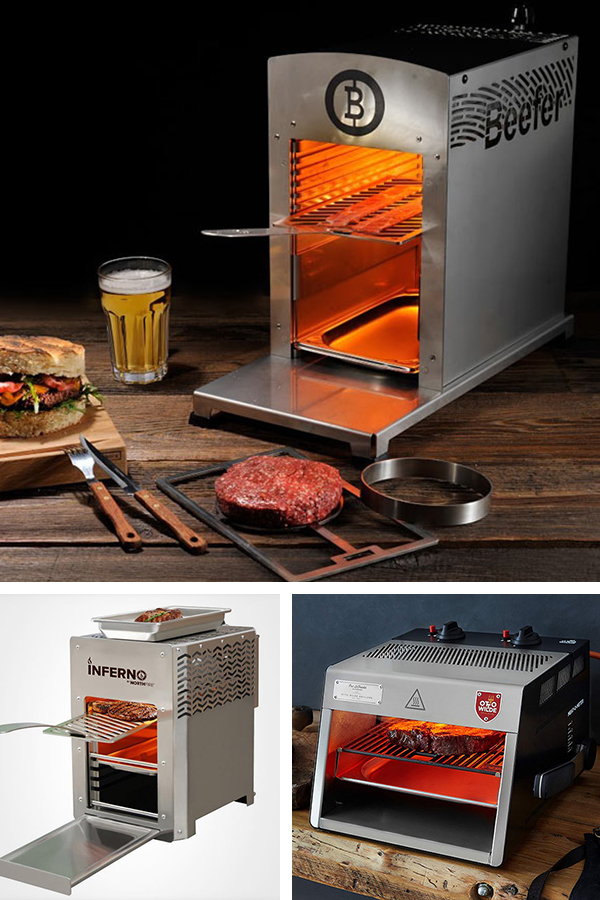
All of these grills are capable of cooking at extremely high temperatures. But the question is, now that you can cook at over 1500°F will you ever visit the steakhouse again?
There aren’t many recipes that require you to cook at such high temperatures. But outdoor cooking isn’t always about following recipes.


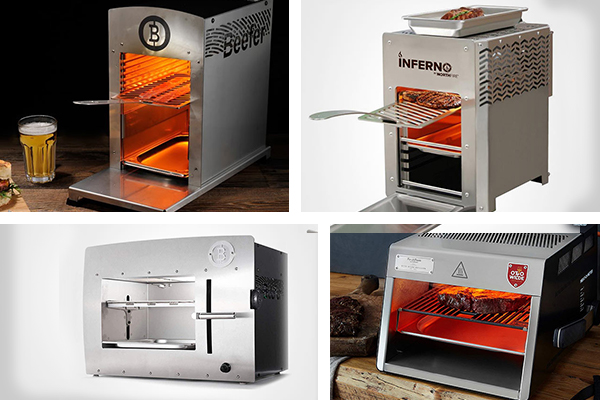
Have you tested the https://schwankgrills.com/
I’m interested in how they compare
In process on that, should be later this fall for posting. Thanks for asking!
-M
Looking forward to the Schwank Grill update.
Do you prefer the cast iron grate in the Otto or the stainless steel in the others?
Also, do you really need to take apart the Otto to clean it? Can you just wipe down the inside?
Thanks for the questions. In terms of grill grate, I prefer the stainless (which Otto offers) just because it’s lighter and easier to clean. There was no noticeable performance difference. While you can clean all of them by wiping them down on the inside, to get a thorough cleaning you really need to disassemble the Otto somewhat, and at the time of testing it wasn’t easy. They may have improved that by now. I hope this helps.
-M
Great thanks!
Have you gotten a hold of the Schwank yet?
Great news for us poor folk lol! The Northfire Inferno has been dropped from $499 to $279!
Schwank comparison please
Hey Mark – Thanks for checking this out. I’m actually in the process of testing the Schwank unit now. I should have it published in the next 3 weeks.
-M
Anything on the Schwank grill yet? I’m torn between the Otto and the Schwank for an outside grill. Also looking between the Gemelli and Kalorik indoor grills. Thanks. SF
The Schwank review should be posted soon. I’ve finished working with it for an extended period of time. In short – it’s an incredible grill.
I’m also looking forward to the Schwank vs. Otto comparison. I know the Ottos are made in Germany, which bodes well for quality. Not sure about Schwank.
hello, ty for review. one person home eating a steak a week maybe. burger a week too. I think it is down to Schwank vs. Otto, unless you say otherwise. sorry to hear Otto is hard to dis-assemble, have they changed that since your writing? ty Tim
Hi Tim, My review for the Schwank is being published this week. It’s the clear winner in the space at this time.
I’ve gotten the searing for med rare down pat. Suggestions as to time and position (in inches from broilers) for medium and well done. TIA
That’s a tricky one to answer as it will depend on the grill you’re using and the thickness and cut of meat. Sorry that’s not very helpful; I wish there was a more “one size fits all” answer to this question.
-M